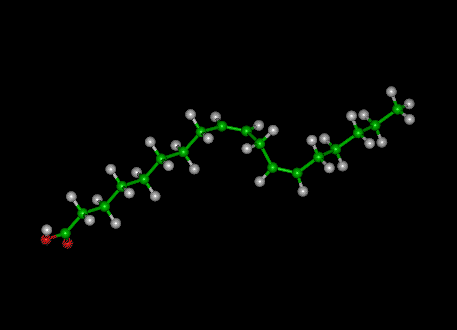Linoleic Acid Molecule

The Linoleic Acid Molecule Ball and Stick Model
To View theLinoleic Acid Molecule in 3D using Jsmol
Physical Properties
Linoleic acid is
an unsaturated fatty acid. Linoleic acid (LA)
is a naturally occurring fatty acid found in beef
,dairy products and oils like safflower and soy
oil, . Linoleic acid is one of the two essential
fatty acids (the other is linolenic acid). Linoleic
acid is an omega-6 fatty acid, meaning that it
is unsaturated, with a double bond occurring at
the sixth carbon atom from the omega end of the
molecule.
Linoleic acid-- CH 3 (CH2)4CH=CHCH2CH=CH(CH2)7COOH
,
Conjugated linoleic acid (CLA) is a mixture of positional and geometric isomers of linoleic acid, which is found preferentially in dairy products and meat. Preliminary studies indicate that CLA is a powerful anticancer agent in the rat breast tumor model with an effective range of 0.1-1% in the diet. While linoleic acid is found in the diet in vegetable oils, the conjugated variety, CLA, is found primarily in meat and dairy products.
Conjugated linoleic acid is unique because it is present in food from animal sources, and its anticancer efficacy is expressed at concentrations close to human consumption levels.
In Health
Linoleic acid is an essential fatty acid that must be consumed for proper health. A diet only deficient in linoleate (the salt form of the acid) causes mild skin scaling, hair loss,[6] and poor wound healing in rats.
Along with oleic acid, linoleic acid is released by cockroaches upon death which has the effect of preventing other roaches from entering the area. This is similar to the mechanism found in ants and bees, which also release oleic acid upon death.[8]
External Readings and References
- Linoleic Acid Molecule-- PubChem
- The efficacy of long-term conjugated linoleic acid (CLA) supplementation on body composition in overweight and obese individuals: a systematic review and meta-analysis of randomized clinical trials.